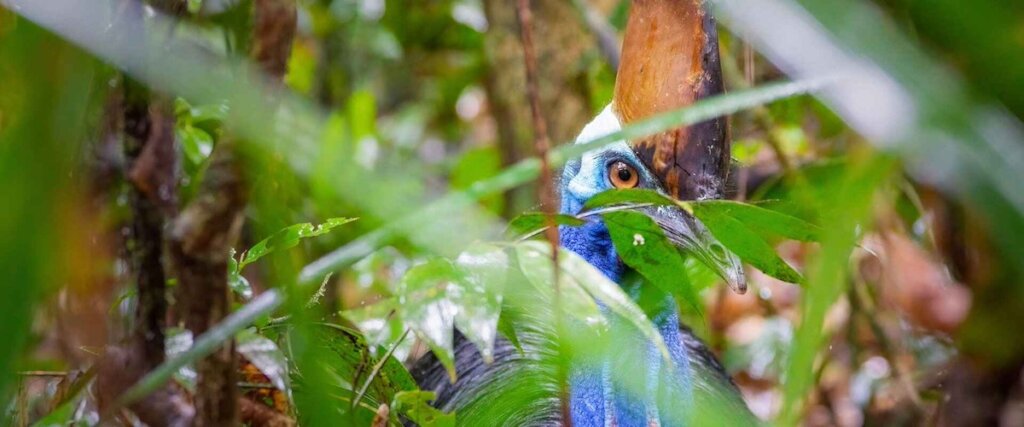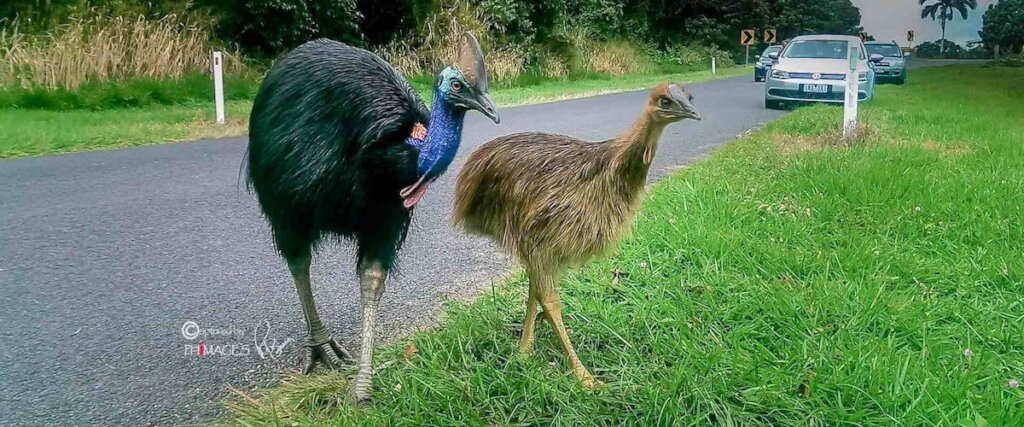By Mark Cox | Communications Manager
COULD ONE BIRD REALLY HAVE AN IMPACT ON EVERYONE IN TROPICAL FAR NORTH QUEENSLAND?
When you are almost 6 foot tall and (perhaps unfairly) nicknamed the ‘murder bird’, then yes. It also helps if you are the focus of a federal government National Recovery Plan to ensure a healthy population of your species. You are, of course, the Southern Cassowary, one of Australia’s most iconic wild species. You are also one of our region’s rarest.
Rainforest Rescue believes that the Recovery Plan will only succeed through conscious community commitment. Relying on government agencies alone is not enough for the level of energy, resourcing and on-the-ground activity laid out in the plan.
It’s evident from the Recovery Plan that the Australian Government concedes this is the case too. But how might this plan benefit all of us as residents of tropical FNQ and put cassowary numbers on the road to recovery?
Because simply put, no plan is an island.
The primary habitat of Southern cassowary is tropical rainforest, ideally covering a large area so that the species can behave, reproduce and thrive as it has done for millions of years. Our region is blessed with swathes of the oldest rainforest in the world, referred to in the Recovery Plan as being ‘hyper-diverse’, meaning an incredible array of species in one environment. But the rainforest can become a fragile and fragmented habitat if not managed carefully.
To achieve the vision of the plan that “a healthy population of the southern cassowary… occupies its full potential range in connected landscapes of functional ecosystems… (where) each population coexists with informed communities” requires cooperation from landowners, local communities, conservation organisations, tourists, and government representatives, working towards a common goal.
If we zoom out, it is apparent that this common goal will have benefits beyond the cassowary. Benefits to us as FNQ locals.
ADDRESSING THREATS AND EMBRACING FUTURE OPPORTUNITIES
Several of the biggest threats to cassowaries also impact on how we live within the Wet Tropics environment. Allen Sheather, Rainforest Rescue’s Ecological Advisor and representative on the Cassowary Recovery Team points out: “While maintaining a healthy habitat for Cassowaries is vital, so too is reducing the incidents of vehicle strikes and attacks by domestic dogs”.
Incidents involving cassowaries and domestic dogs suggest that minimising nuisance behaviour from pets would benefit our neighbours and the birds themselves. Cassowary casualties from road traffic that intersects cassowary habitat places a focus on regional roads, with the potential to prioritise funds for local road upgrades and safety enhancement strategies. Further, cassowaries are also at high risk from interactions with feral pigs–a contentious animal which causes excessive damage to agricultural crops, livestock pasture and other native species.
We foresee that Far North Queensland will experience the effect of the Land Restoration Fund, Biodiversity Credits and Natural Asset Companies. Each is a way to adjust the value we place on the environment. We can expect to see increasing restoration of Wildlife Corridors and changes in land use on farms, for example, leading to further sensitivity in the zoning of land.
One of the drivers for the development and operation of our large-scale biodiverse tree nursery in FNQ is to support the emergent “green economy” which is intertwined with the various restoration-for-payment schemes that are coming into play in FNQ. Our commitment to supporting restoration in the region could not be firmer. As Allen Sheather concurs: “After all, to restore rainforest, you must have trees!”
The draft Recovery Plan offers private landowners the opportunity to rethink their own land use, for some this may lead to the creation of Nature Refuges. At a micro-level, it allows residents to realise that ‘backyard conservation’ is a tangible reality.
A SPECIES OF SIGNIFICANCE TO MANY
Gunduy (Cassowary) are culturally significant animal to indigenous people. Historically, the bird was a food source to rainforest people, featuring in stories, song, dance and as a totem species. In learning more about the cassowary’s relationship to the rainforest, we’re providing a way for us to deepen our understanding of traditional owner heritage and connection to Country.
Cassowaries, like the cuddlier koala, are a tourism drawcard, people flock to this corner of Australia to see them in the wild and gain knowledge about the rainforest ecosystem they inhabit. Our local economies benefit from charismatic species like the cassowary as part of the region.
Within our schools, where Australian students learn about rainforest biodiversity, the cassowary is a significant symbol of how a natural environment connects many species for an ecosystem to operate in a healthy and successful manner. Citizen science, even at the most rudimentary level, connects people to the environment around them. The data collected by local people in their nearby region is critical to gauging the success of conservation efforts.
Rainforests in general are of great benefit to our health too. Not only as nature’s medicine cabinet, but as natural air filters and as natural air conditioners for cooling. While evidence suggests they can have positive impacts on our mental health.
The draft Recovery Plan indicates that much like many other species, the Southern cassowary is susceptible to the impact of Climate Change. As are we. In addressing the impacts on the cassowary, we also address those that will affect us as local communities, especially with increasing adverse weather events taking place.
The status and outcomes of this draft Recovery Plan sets a precedence for those that follow, providing an indicator of the state of our relationship with wild species and the natural environment. The final Recovery Plan’s success could snowball into the way other native wildlife is protected.
Altogether, these considerations amount to a more holistic, connected way of living. A way that we need to get used to if we’re going to tackle Climate Change head on, as well as the shift to clean energy and dealing with spiralling resource prices. Ultimately, this relates to a healthy and vibrant environment. This plan helps to provide that, with necessary community guidance.
WORKING TOGETHER TO ACHIEVE MORE
For many years, Rainforest Rescue has worked tirelessly to regenerate and protect FNQ’s rainforests. We’re now part of the Wet Tropics Restoration Alliance, developed to help provide resources and guidance for restoration professionals and support for groups like Rainforest Rescue, and by working together we can achieve more in the region. Our protected rainforest properties have evidence of cassowaries and their young returning to areas that were once devoid of them, so we know firsthand that recovery is possible. It may take time, but it will work.
From all of us at Rainforest Rescue we have a simple request – in considering the future of the cassowaries, you’re also considering the future of our region and its communities.
Project reports on GlobalGiving are posted directly to globalgiving.org by Project Leaders as they are completed, generally every 3-4 months. To protect the integrity of these documents, GlobalGiving does not alter them; therefore you may find some language or formatting issues.
If you donate to this project or have donated to this project, you can recieve an email when this project posts a report. You can also subscribe for reports without donating.
Support this important cause by creating a personalized fundraising page.
Start a Fundraiser
